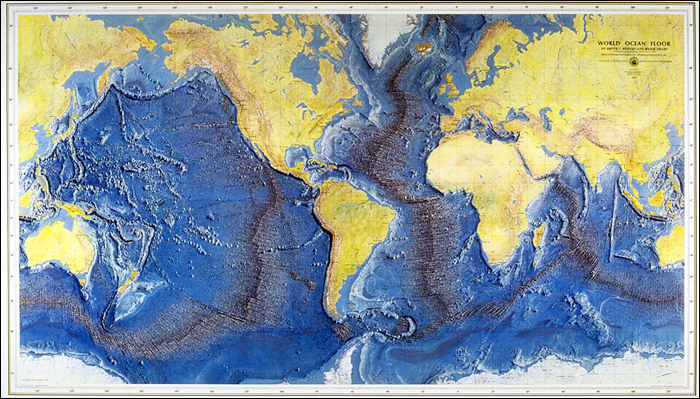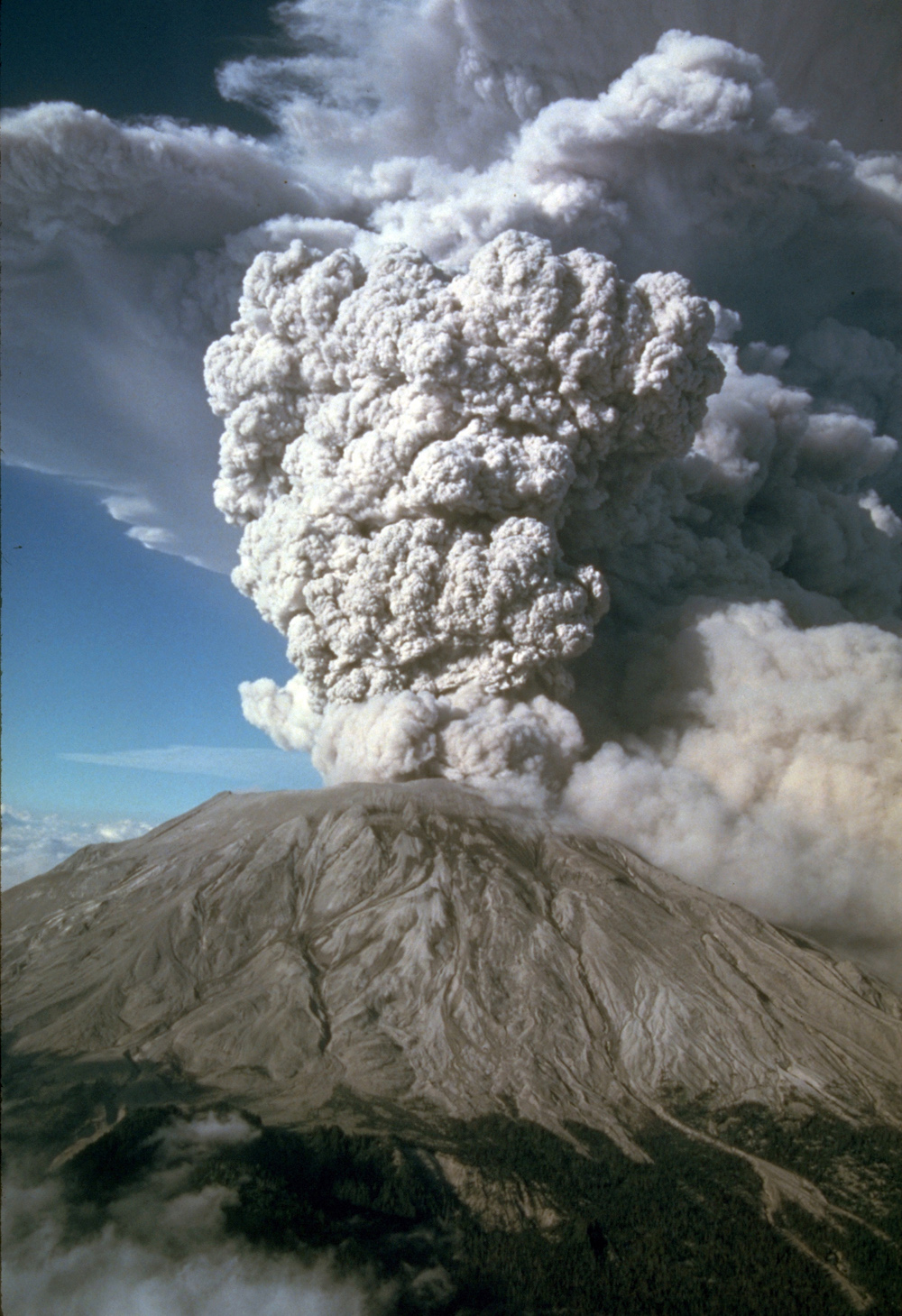The answer to the above question may at first seem obvious, since oceans are full of water and continents rise above sea level. But to scientists, this “obvious” answer raises a deeper question: why does Earth have oceans and continents, and why are the continents arranged as we see them on the globe? After all, if you think about it, you could imagine many other ways in which Earth could have been arranged.
Discussion
Oceans Without Continents
Briefly discuss ways in which it might in principle be possible for Earth to be arranged differently from its current arrangement of oceans and continents. Can you think of ways in which there might have been no large land masses at all, even if Earth still had the same total amount of rock and ocean water?
This discussion simply asks students to imagine some of the different possible arrangements alluded to above. Notes:
- Be sure students think about possible alternate arrangements of the continents, since that will set the stage for discussion plate tectonics in the next section. For example, some students may already know about Pangaea as a “super continent” in the distant past.
- For the second part of the question, there are at least two possible answers: (1) We could image that the entire Earth had a uniform elevation, so that the ocean would be spread across the entire surface, with no land rising above sea level anywhere. (2) We could imagine that instead of large continents, Earth might have vast numbers of small islands that add up to the same total amount of land above sea level.
To answer the question of why Earth is arranged as it is, we need to investigate whether the parts of Earth covered by oceans differ in any fundamental way from the parts covered by continents. It turns out that they do, and that in understanding these differences, we’ll learn a lot about the processes that shape our planet.
Seafloor and Continental Crust
The key differences between oceans and continents are found in the crust that lies beneath them. In particular, the crust found beneath the seafloor, or seafloor crust , differs from continental crust in three important ways, all summarized in Figure 5.2.1–1:
- Seismic wave studies show that seafloor crust is much thinner than continental crust. Seafloor crust is typically only about 5 to 10 kilometers thick, compared to 20 to 70 kilometers for continental crust.
- Comparisons of rock samples from the seafloor and continent show that seafloor crust is denser than continental crust.
- Absolute dating techniques (mainly radiometric dating) show that seafloor crust is generally much younger than continental crust. In fact, virtually all seafloor crust is less than 200 million years old, which is very young in geological terms compared to continental rocks that can be up to 4 billion years old.
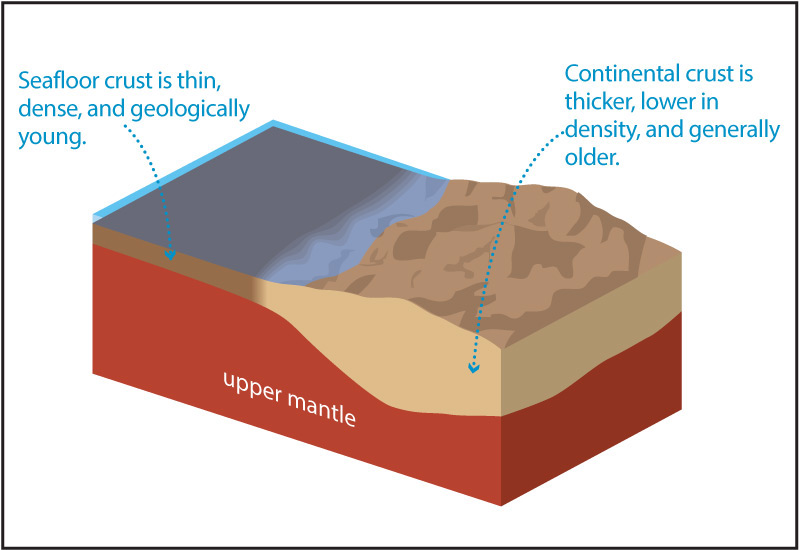
The first two differences — thickness and density — explain why the continents stick up above the oceans. As you can see in Figure 5.2.1–1, the added thickness of the continents makes them stick up higher than the ocean basins, even though their sheer weight pushes them deeper down in the mantle. This is where their lower density comes in: If continental crust was as dense as seafloor crust, the continents would weigh even more and sink even further into the mantle, offsetting their added thickness. But the lower density means a lower weight than they would otherwise have, so that they end up sticking up well above the ocean floors.
Figure 5.2.1–2 shows a global map of crustal thickness. Notice that the differences in thickness between seafloor and continental crust are quite significant and hold true all around the world.
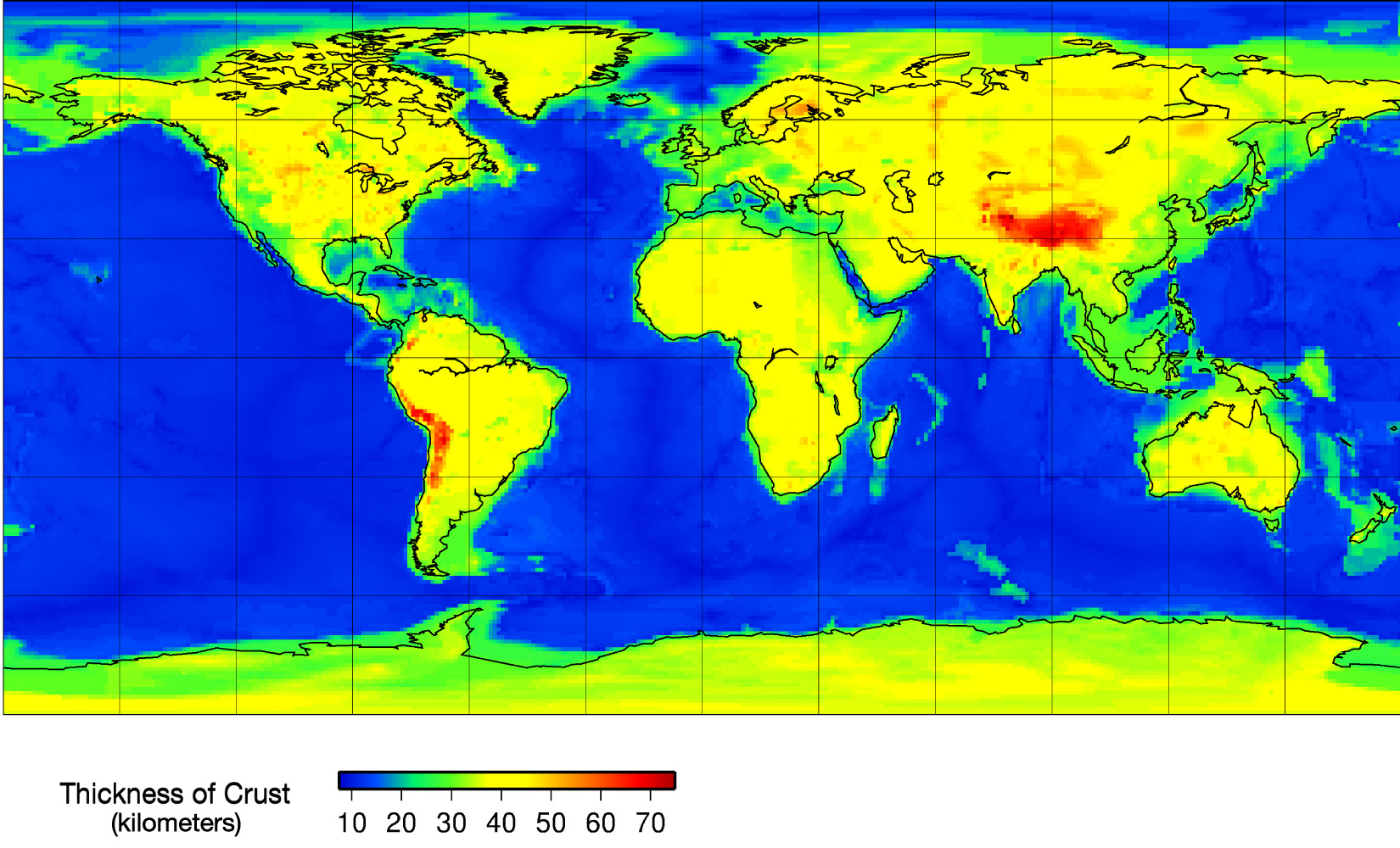
Quiz
Note: As always, after you finish the quiz, be sure you read the feedback that explains the correct answers, to make sure you understand the reasons for these answers.
Origin of the Seafloor
Why would seafloor crust be so different from continental crust? A key clue comes from looking at the ages of seafloor rock more closely. Figure 5.2.1–3 shows the data. Study it carefully, then try the discussion that follows.
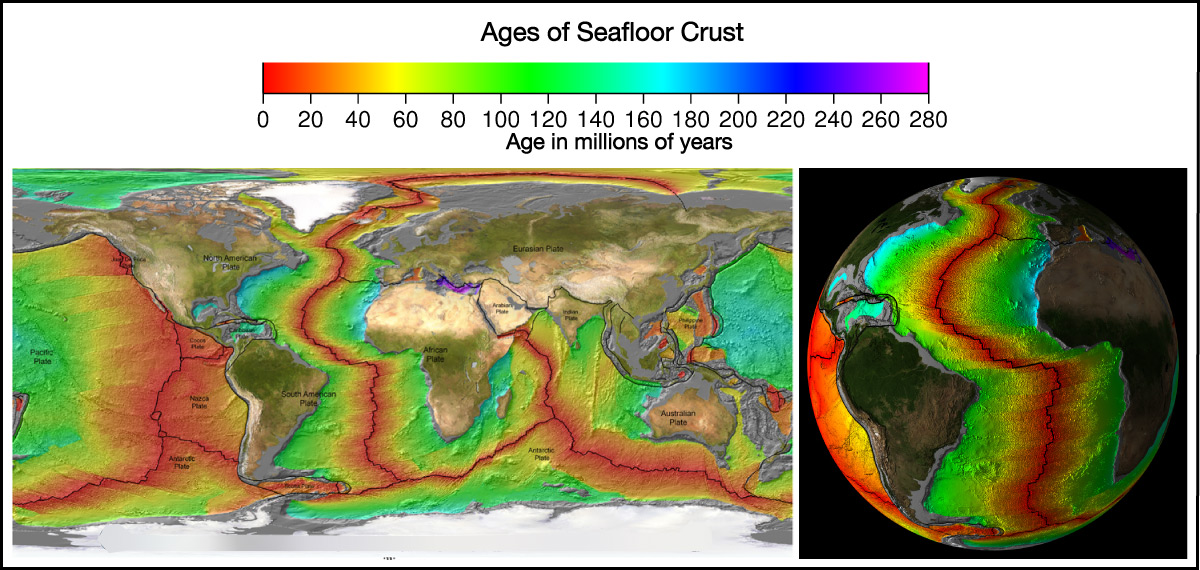
(a) This flat map shows ages of seafloor crust for the entire world, along with plate boundaries and the names of the plates. (Recall that you have seen the plate boundaries earlier in Figure 4.19.)
(b) Here we see the same data on a globe for the
half of Earth that includes the Atlantic Ocean.
Figure 5.2.1–3 – These maps show the ages of seafloor crust, revealing clear patterns of young crust along mid-ocean ridges and older crust as you move away from the ridges. The maps do not show ages of continental crust, which is generally much older than seafloor crust. Credit: Mr. Elliot Lim, CIRES & NOAA/NCEI.
Discussion
Making Sense of Seafloor Rock Ages
Carefully study Figure 5.2.1–3, thinking about what you see in the context of Earth’s overall geography that we discussed in Chapter 4; you might in particular want to review Figure 4.12. Then discuss the following questions in small groups or as a class.
- In general, where is the youngest seafloor crust found?
- What must be happening in the areas where the youngest seafloor crust is found in order to explain its geologically young age?
- Do you notice any pattern to how the age of the seafloor changes as you move away from the youngest crust?
- Based on your answers to the first three questions, form a hypothesis about why the pattern we see in seafloor crust age exists.
- Form another hypothesis to explain what must happen to seafloor crust when it nears continents in order to explain the abrupt change in age between seafloor and continental crust (which is generally much older).
This important discussion will help students recognize how the study of seafloor ages leads to the conclusion that seafloor spreading is occurring outward from the mid-ocean ridge system. Notes:
- (1) The youngest seafloor crust follows the global mid-ocean ridge system. To see this, students should notice first that the red color in Figure 5.2.1–3 represents the youngest seafloor crust. Then, they should notice that the red on the seafloor age map traces the same path as the mid-ocean ridge system shown in Figure 4.1.
- (2) The only logical explanation for finding such young crust is to assume that it has recently erupted from volcanoes. This explanation is correct, because the mid-ocean ridges are indeed lined with volcanic vents that are erupting and thereby bringing new rock to the ocean floor.
- (3) Yes, there is a pattern: as you go farther from the mid-ocean ridges, you see older crust.
- (4) The simplest hypothesis would be to imagine that new seafloor crust erupts to the ocean floor along the mid-ocean ridges, then gradually moves away from the ridges with time, so that we see older crust at greater distance from the ridges. This is, of course, the correct hypothesis, as we’ll discuss below and then put in the context of plate tectonic theory in Section 5.3.
- (5) The abrupt change tells us that the seafloor crust is somehow disappearing when it reaches the continents (before it can get any older), which means it must be subducting down under them. It is the seafloor crust that subducts downward because of its higher density.
The above discussion will hopefully have made you realize that molten rock from the mantle must be constantly emerging along mid-ocean ridges to make new seafloor crust, which then gradually makes its way across the seafloor until it finally slides back down (“subducts” ) into the mantle. Figure 5.2.1–4 summarizes this process. The fact that the entire process takes less than about 200 million years explains why seafloor crust is always geologically young. Continental crust can be much older, because it is not recycled into the mantle in the same way.

Claim-Evidence-Reasoning Activity
Seafloor Spreading
You’ve now learned a lot about the seafloors here and in Chapter 4. To consolidate all you’ve learned, construct a clear argument using evidence and reasoning to support the following claim.
Claim: Seafloor crust is produced along mid-ocean ridges, then gradually migrates across the ocean basin until being destroyed near the edges of continents.
This CER activity is designed to make sure students have absorbed the ideas we’ve been discussing, in preparation for putting them all together into the theory of plate tectonics as we’ll discuss in Section 5.3. Students should be able to support the claim based on what they’ve already learned. Key evidence that they should cite includes:
- The age evidence in Figure 5.2.1–3 is highly suggestive of seafloor spreading, as covered in the Discussion “Making Sense of Seafloor Rock Ages.”
- The fact that the mid-ocean ridges are lined with volcanoes adds to this evidence, since it shows that there is indeed a source for new seafloor.
- Although we have not yet reviewed it in this chapter, some students will also recall from Chapter 4 that we typically find trenches — where subduction occurs — near continents (or island arcs, which are also relatively near continents), which fills in another piece of the puzzle.
Origin of the Oceans (and Atmosphere)
We’ve talked about how seafloors are formed, but you might still wonder: How did all the water get there?
The answer goes back to a process we discussed briefly in Chapter 4: outgassing by volcanoes (see Figure 4.52). As Earth formed, some gases became trapped in its interior (review this box to see how). Inside the Earth, these gases are held in place by the interior pressure in much the same way that the gas in a soda bottle is trapped before you open it. Just like the gas that escapes the soda bottle after you open it, the gas trapped within Earth can be suddenly released when molten rock erupts to the surface.
Careful studies of modern-day volcanoes tell us that vast amounts of water vapor (H2O) must have been outgassed by early volcanoes. Once released into the atmosphere, this water vapor cooled and condensed to make rainfall, which then began to fill the oceans (Figure 5.2.1–5). In other words, outgassing released most of the water that makes up Earth’s oceans today.
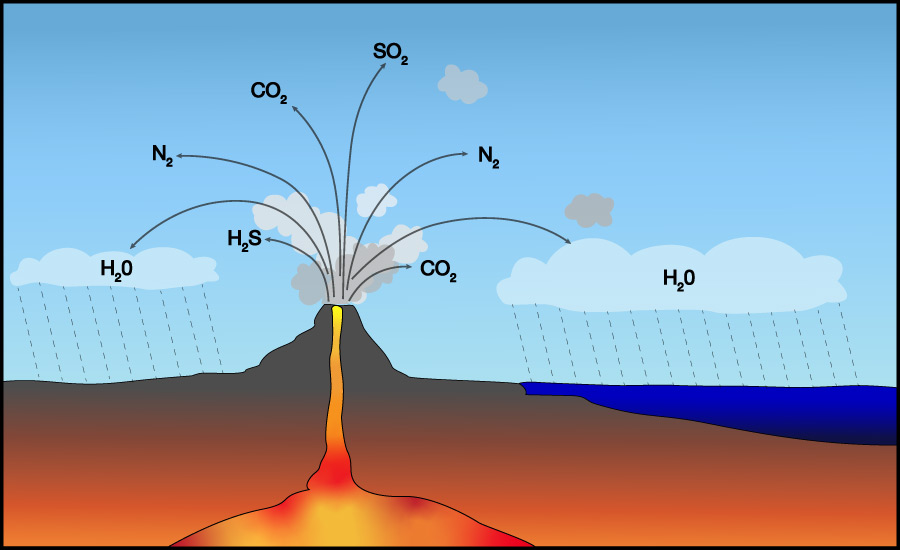
Notice in Figure 5.2.1–5 that water vapor wasn’t the only gas released. Other major gases released by early volcanoes included carbon dioxide (CO2), nitrogen (N2), and sulfur-bearing gases (such as H2S and SO2). These “other” gases must therefore have made up Earth’s early atmosphere. In other words, the early atmosphere must have been very different from our atmosphere of today, which is dominated by nitrogen (78%) and oxygen (21%).
Discussion
Death in an Early Earth Time Machine
Imagine that you had a time machine, and you went back in time to visit the Earth when its oceans were first forming. In small groups or as a class, discuss which of the following would have been most likely to kill you first:
A. High temperatures.
B. Lack of air pressure.
C. Lack of breathable air.
D. Stepping in molten lava.
E. Getting hit on the head by a meteorite.
Be sure to explain your answer, and also explain why the other answers are incorrect.
This can be a fun discussion about a hypothetical time machine adventure. The correct answer is C, since there was no oxygen in the early atmosphere. In terms of why the other answers are not correct:
- (A) – the fact that oceans were forming tells us that temperatures must not have been that high, or else the water vapor would not have condensed into liquid form.
- (B) –the fact that oceans were forming also tells us there must have sufficient air pressure to allow for surface liquid water.
- (D) – again, the fact that oceans were forming means the ground was not covered everywhere by molten lava.
- (E) – Although meteorite impacts were much more common early in Earth’s history than they are today, they still would have been rare events. You can figure this out because if they were happening all the time, the heat of such frequent impacts would have been too much to allow the oceans to form. So even at very early times, impacts would have been only a very minor danger to time travelers.
